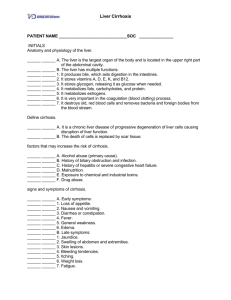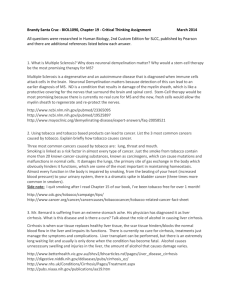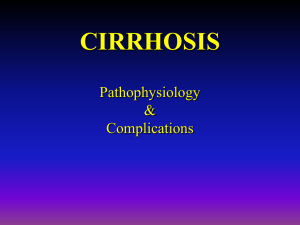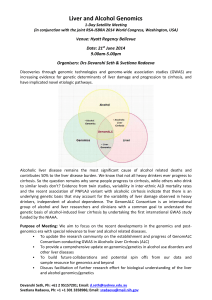Radiographic Evidence of Liver Cirrhosis & Sequelae
advertisement
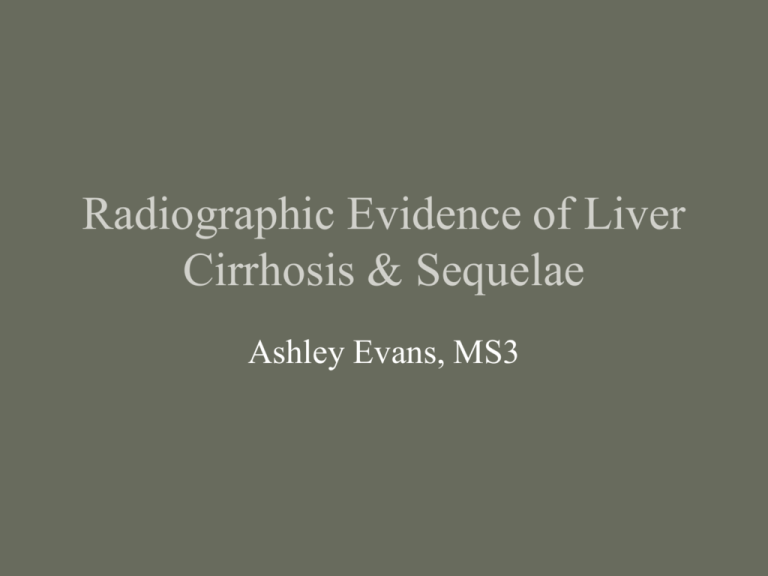
Radiographic Evidence of Liver Cirrhosis & Sequelae Ashley Evans, MS3 Liver Cirrhosis • Cirrhosis is the result of: Alcoholic liver disease Viral hepatitis Primary biliary cirrhosis Primary sclerosing cholangitis Congestive hepatopathy, Wilson’s disease, Hemochromatosis, In North America, ~75% of cirrhosis cases are attributed to chronic alcoholism1 Cirrhosis • Among the leading causes of death in the western world • Pathologically defined by 3 main characteristics: – Fibrosis – Nodular transformation – Distortion of hepatic architecture Pathophysiology of Cirrhosis Insult to Liver Cells Cell Necrosis and Regeneration Diffuse Fibrosis Regenerating Nodules Destruction of Histological Structure Hallmark Findings • Nodular Liver • Portal Hypertension • Hepatofugal Portal Venous Flow – Portosystemic Vascular Shunts • Esophageal varices • Gastric varices • Superficial abdominal wall collaterals – Ascites – Splenomegaly • Hepatocellular Carcinoma • Hepatopulmonary Syndrome Why Do We Image? • Characterize the morphologic manifestations of the disease • Evaluate the hepatic and extrahepatic vasculature • Assess the effects of portal hypertension • Detect hepatic tumors Numminen, et al. Scandinavian Journal of Gastroenterology; 2005 Imaging Options CT Scan MRI Ultrasound Angiography Murakami, Seminars, 2001. Cirrhosis: Characteristic Findings • Nodularity CT Normal – Best seen affecting the liver margin (especially left lateral) • Cobblestone appearance • Diffuse heterogeneity of liver parenchyma • Atrophy of the right lobe and hypertrophy of the left and caudate lobes Van Beers, et al. AJR; 2001 MRI Chronic Cirrhosis Murakami, Seminars, 2001. Cirrhosis: Early Imaging Changes • Enlargement of the hilar periportal space • Enlargement of the major interlobar fissure • Expansion of pericholecystic space or gallbladder fossa Numminen, et al. Scandinavian Journal of Gastroenterology; 2005 Portal Hypertension • Responsible for the most devastating complications of end-stage liver disease: – Upper GI bleeding – Ascites – Hepatic encephalopathy Portal Hypertension • Extensive fibrosis of the spaces of Disse • Nodular regeneration – Resistance to sinusoidal blood flow – Intrahepatic mesenteric vasodilators – Extra- and intrahepatic portosystemic anastomoses develop to divert some portal venous blood directly into the systemic venous circulation Kang, et al. Radiographics: 2002 Hepatofugal Blood Flow 79 yoF with alcoholic cirrhosis The finding of a small main portal vein strongly correlates with hepatofugal flow6 Bryce, et al. AJR; 2003 Hepatofugal Blood Flow 49yoM Hep C cirrhosis Enhancement of the portal vein during arterial phase indicates hepatofugal portal venous flow6 Bryce, et al. AJR; 2003 Portosystemic Vascular Shunts • Variceal hemorrhage is a devastating complication that occurs in 25 to 40 percent of patients with cirrhosis – – – – – Gastroesophageal collaterals Superficial collaterals Splenorenal shunts Retroperitoneal and mesenteric collaterals Transhepatic Portosystemic collaterals • Recanalized paraumbilical vein • Hepatic surface collaterals Esophageal Varix CT scan shows a tortuous, enlarged paraesophageal varix (arrows). Kang, et al. Radiographics: 2002 Gastric Varix Axial CT scan shows dilated left gastric vein between the anterior wall of the stomach and the posterior surface of the left hepatic lobe Kang, et al. Radiographics: 2002 Anterior Abdominal Wall Collaterals • CT appearance of the anterior abdominal wall in a normal patient at the level of the umbilicus • CT showing multiple collateral superficial veins Groves, et al. BJR; 2002 What is the significance of collateral vessels? Groves, et al. BJR; 2002 The maximal number of superficial collaterals on a CT image was significantly greater (p<0.02) in a cirrhotic cohort than a control cohort Ascites • Def: accumulation of fluid within the peritoneal cavity • Most common complication of cirrhosis – Due to elevated portal pressures, low albumin levels • Nearly 60% of patients with compensated cirrhosis will develop ascites in 10 years – 2 year survival of patients with ascites is ~50%8 • Can develop into spontaneous bacterial peritonitis (SBP) Ascites • In most cases, the attenuation of the ascites is that of clear fluid, measuring around 0 HU • If the attenuation of ascitic fluid is significantly greater than 0 HU, this should raise concern for hemorrhage or SBP T2 weighted MRI with fluid around right lobe Chopra, et al. Radiology; 1999 CT scan demonstrating ascites Bryce, et al. AJR; 2003 Splenomegaly • Common in patients with severe portal hypertension • Although the spleen may become massive, it is usually asymptomatic • May contribute to the thrombocytopenia or pancytopenia of cirrhosis Splenomegaly T1-weighted MRI demonstrates nodular liver, fibrosis, splenomegaly. Murakami, Seminars, 2001. Hepatocellular Carcinoma • Risk of HCC in patients with cirrhosis due to hepatitis C is approximately 100x the risk of non-infected cirrhotics (alcoholic cirrhosis is 2-3x increased risk)1. • Incidence is rising in the United States – Has almost doubled over the past 20 years, most likely due to rising incidence of Hep C Detection of HCC • Commonly diagnosed by ultrasound on routine screens of cirrhotic livers • CT and MRI are useful to characterize any hepatic tumors detected by US Ultrasound of welldifferentiated HCC Murakami, Seminars, 2001. Hepatocellular Carcinoma HCC show in precontrast CT (left), arterial phase (middle) and equilibrium phase (right). Large HCC shown by T1 spin echo (left) and T2 spin echo (right). Detection of HCC • Detection of liver lesions is dependent on contrast difference between normal parenchyma and the nodules. – This is affected by cellularity, fibrosis, fatty change and vascularity of nodules • Arterial phase CT scan is thought to be the most useful technique for detecting hypervascular tumors such as HCC. Hepatopulmonary Syndrome • Defined by the triad of: – Liver disease – Increased A-a gradient on room air – Evidence for intrapulmonary vascular abnormalities • Signs and symptoms: – Dyspnea, platypnea, orthopnea Hepatopulmonary Syndrome • On CT scans, pulmonary vessels are enlarged, do not taper normally, extend to the pleural surface, and are most numerous in the bases • The ratio of the diameter of the segmental arteries to the diameter of the accompanying bronchi is increased in hepatopulmonary syn. Lee, et al. Radiology; 1998. The End References 1. 2. 3. 4. 5. 6. 7. 8. 9. 10. Murakami T. Mochizuki K. Nakamura H. “Imaging evaluation of the cirrhotic liver.” Seminars in Liver Disease. 2001; 21(2):213-24. Gupta AA. Kim DC. Krinsky GA. Lee VS. “CT and MRI of cirrhosis and its mimics.” American Journal of Roentgenology. 2004; 183(6):1595-601. Sheth S. Horton KM. Fishman EK. “Vascular sequelae of cirrhosis: evaluation with dual-phase helical CT.” Abdominal Imaging. 2002; 27(6):720-7. Kang HK. Jeong YY. Choi JH. Choi S. Chung TW. Seo JJ. Kim JK. Yoon W. Park JG. “Threedimensional multi-detector row CT portal venography in the evaluation of portosystemic collateral vessels in liver cirrhosis.” Radiographics.2002; 22(5):1053-61. Numminen K. Tervahartiala P. Halavaara J. Isoniemi H. Hockerstedt K. “Non-invasive diagnosis of liver cirrhosis: magnetic resonance imaging presents special features.” Scandinavian Journal of Gastroenterology. 2005; 40(1):76-82. Bryce TJ. Yeh BM. Qayyum A. Pacharn P. Bass NM. Lu Y. Coakley FV. “CT signs of hepatofugal portal venous flow in patients with cirrhosis.” American Journal of Roentgenology. 2003;181(6):1629-33. Van Beers BE. Leconte I. Materne R. Smith AM. Jamart J. Horsmans Y. “Hepatic perfusion parameters in chronic liver disease: dynamic CT measurements correlated with disease severity.” American Journal of Roentgenology. 2001; 176(3):667-73. Goldberg, E., Chopra, S. “Overview of the complications, prognosis, and management of cirrhosis.” UTDOL. Aug 18, 2005. Lee KN. Lee HJ. Shin WW. Webb WR. “Hypoxemia and liver cirrhosis (hepatopulmonary syndrome) in eight patients: comparison of the central and peripheral pulmonary vasculature.” Radiology. 1999; 211(2):549-53. Chopra, S. Dodd, GD. Chintapalli, KN. Esola, CC. Chiatas, AA. “Mesenteric, omental and retroperitoneal edema in cirrhosis: frequency and spectrum of CT findings.” Radiology. 1999; 211: 737-742.


